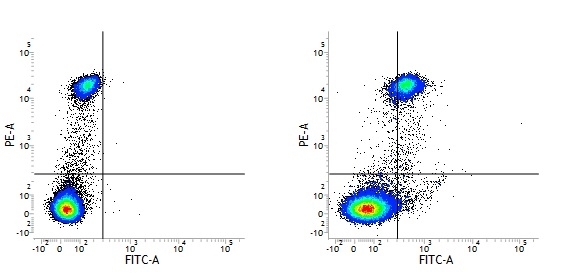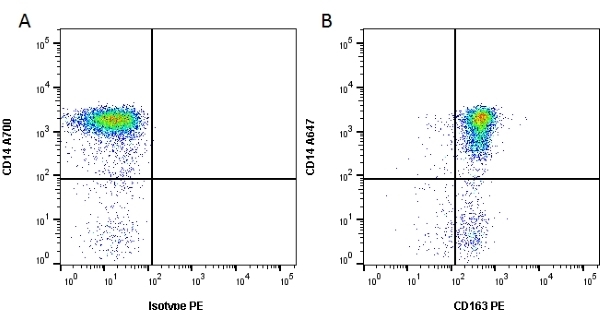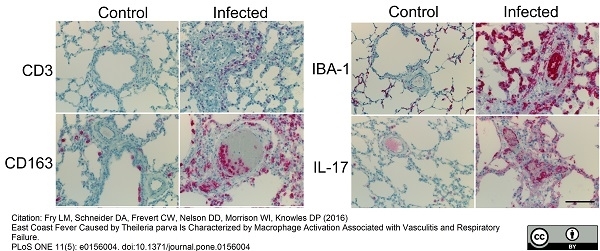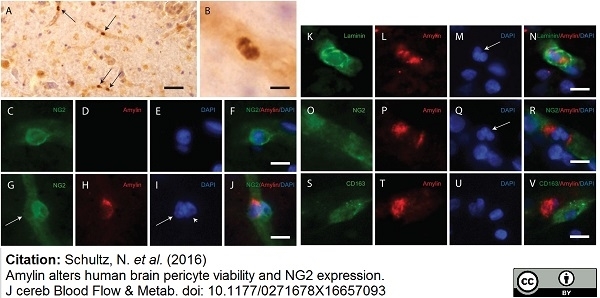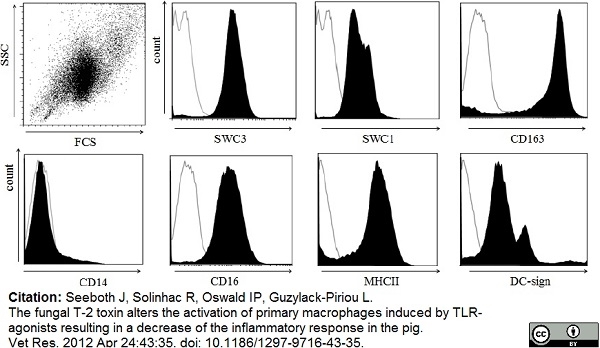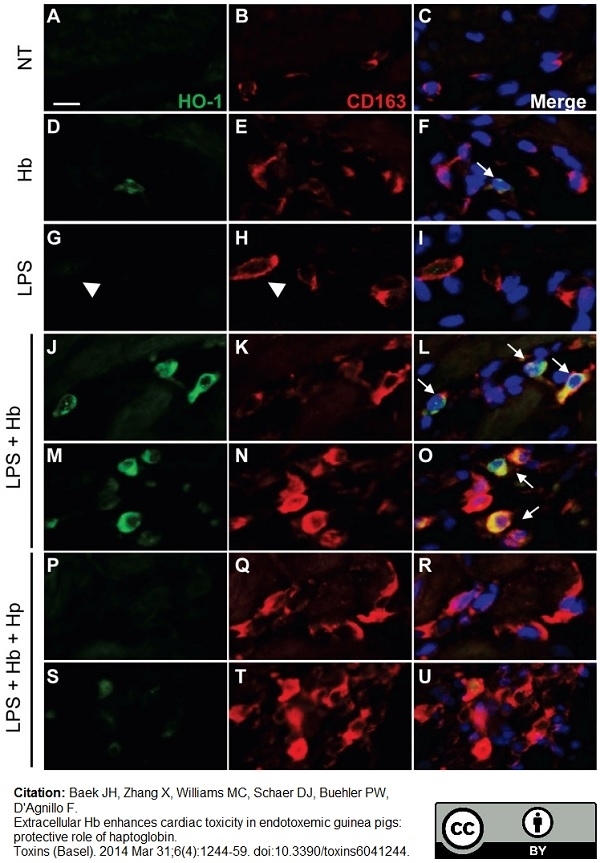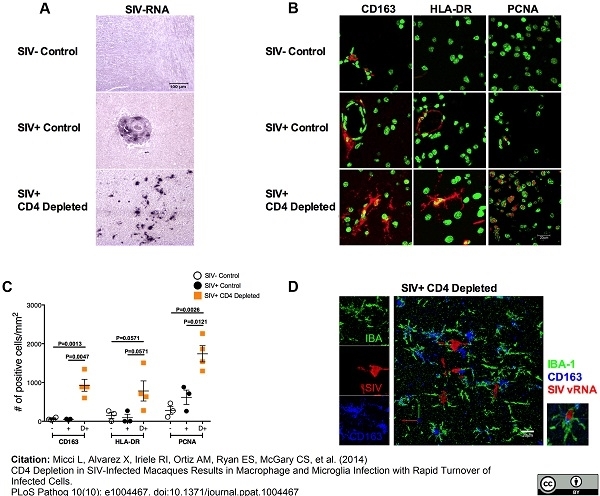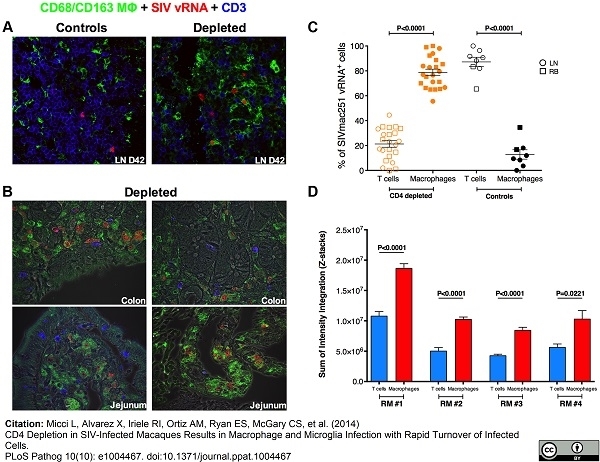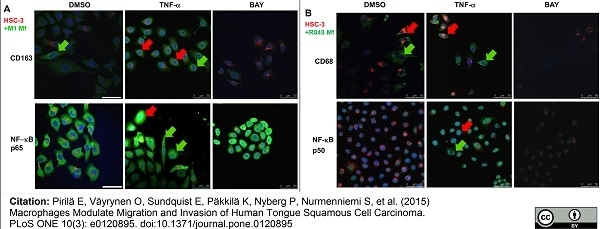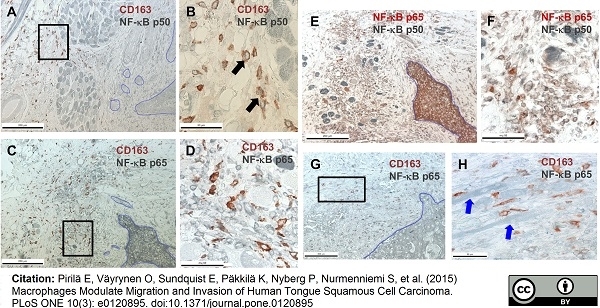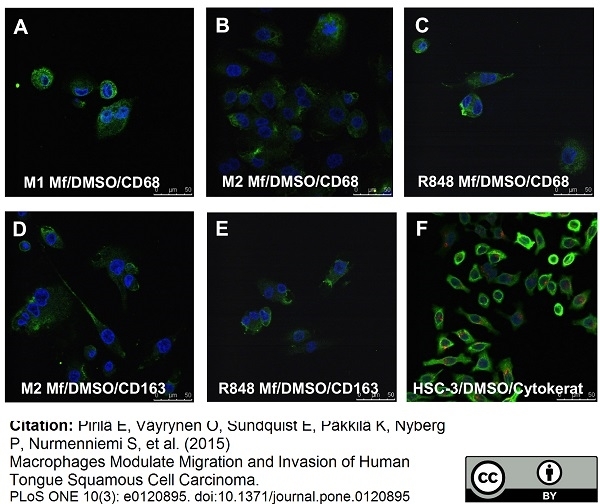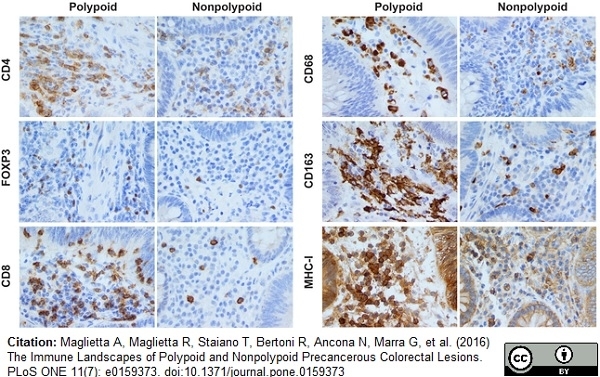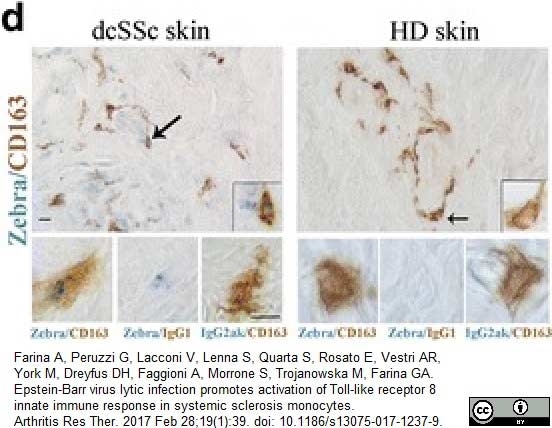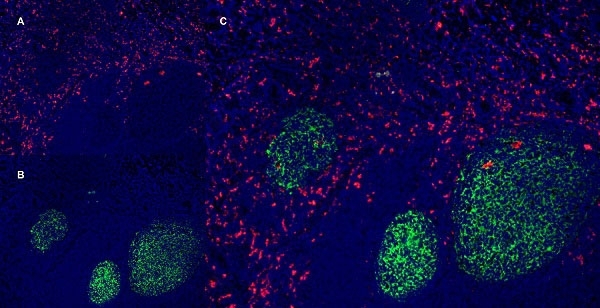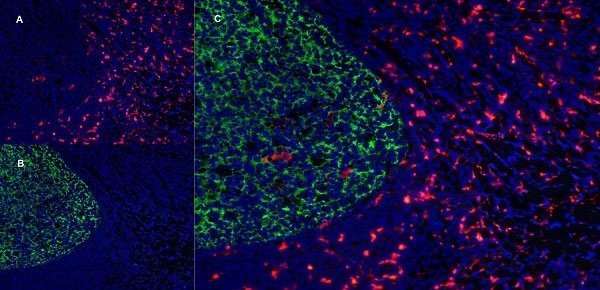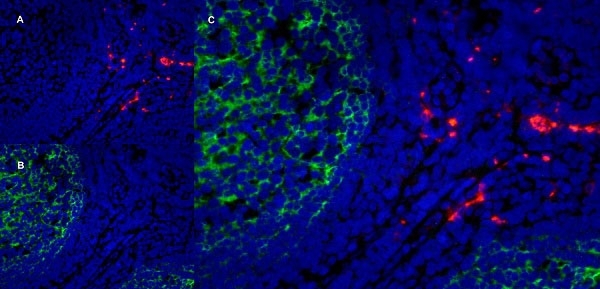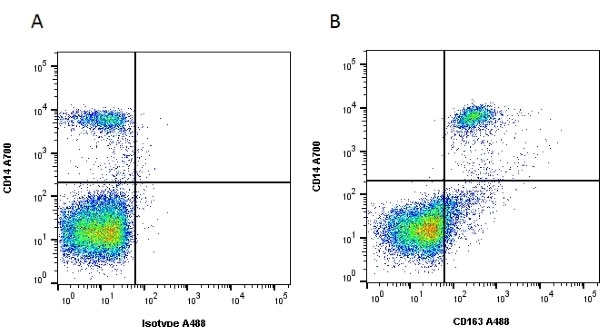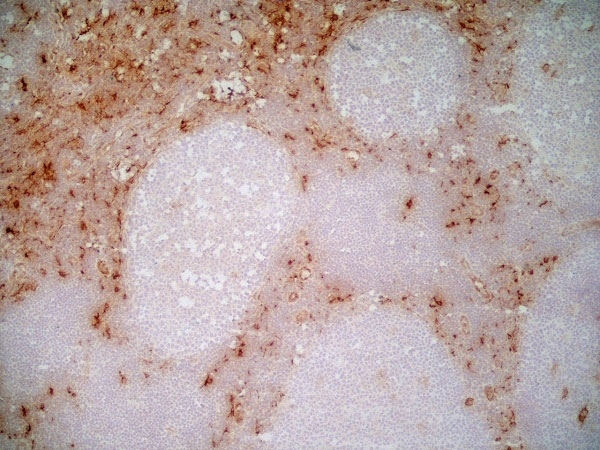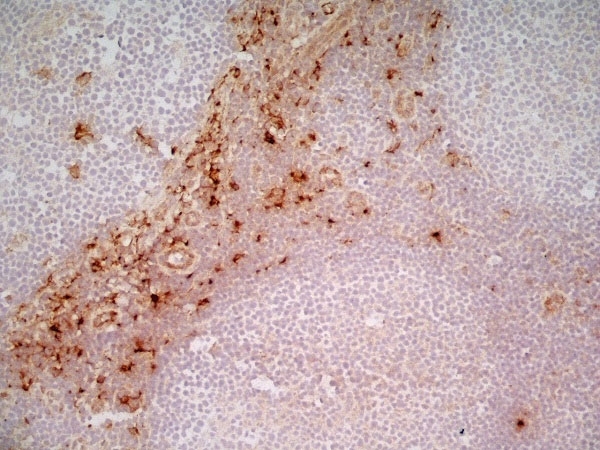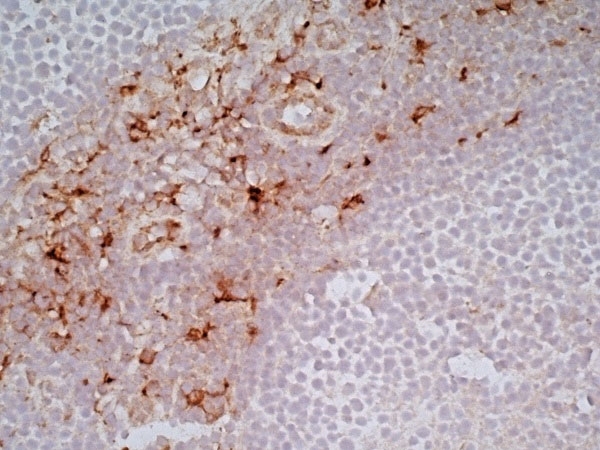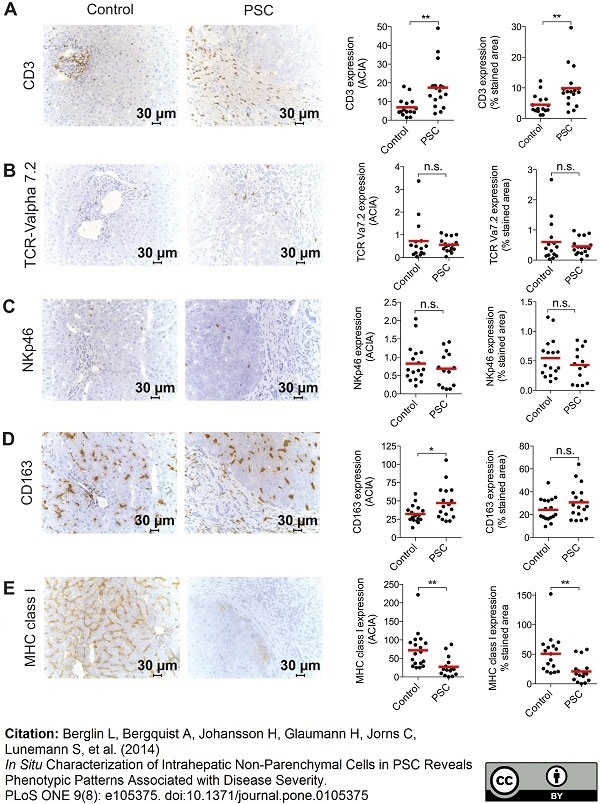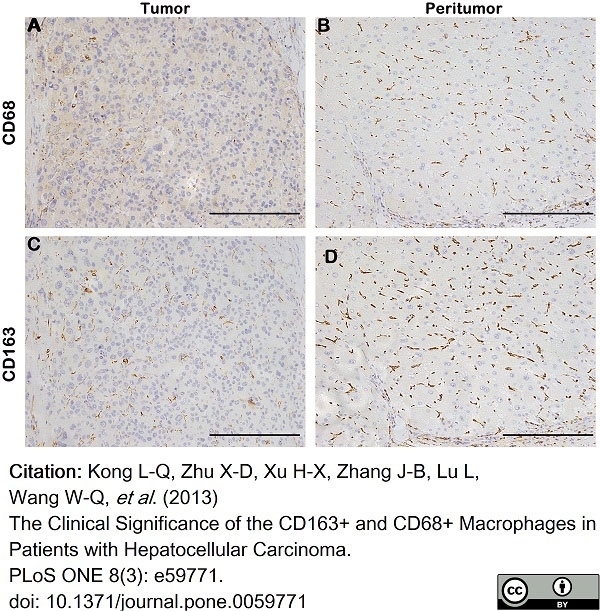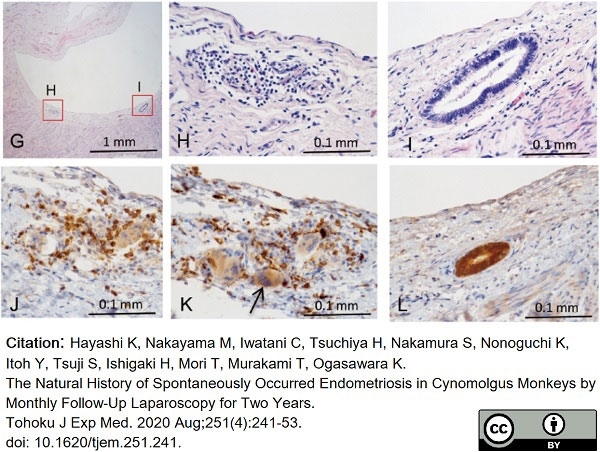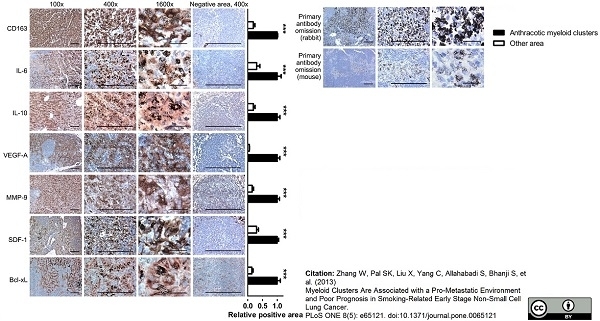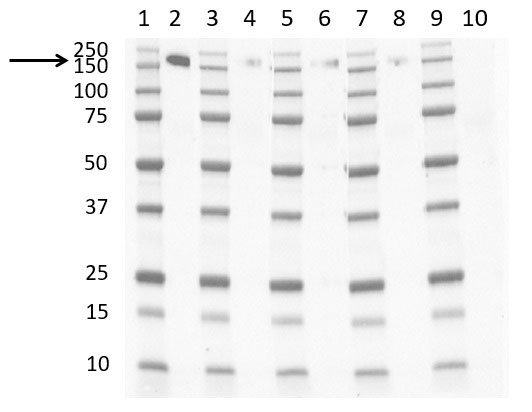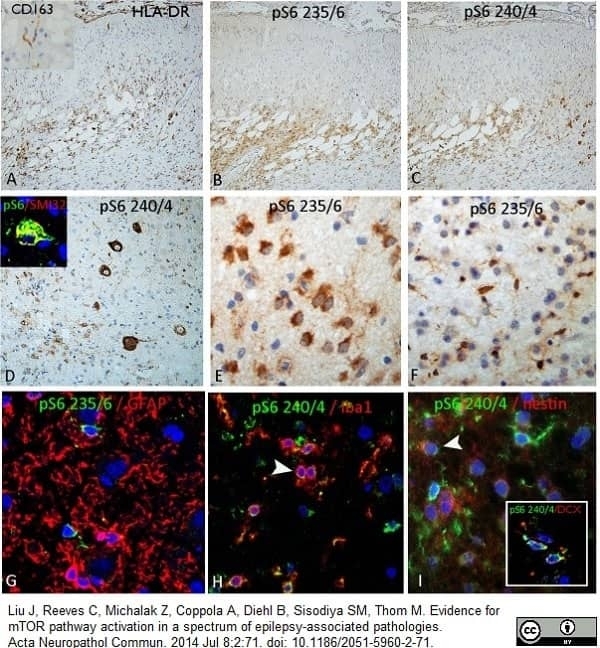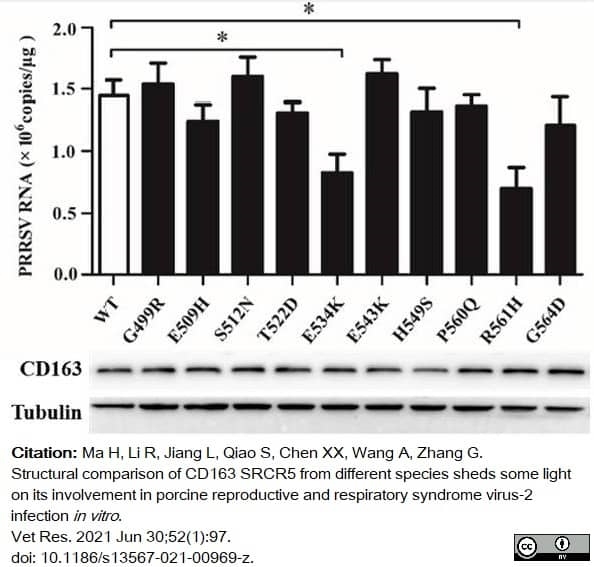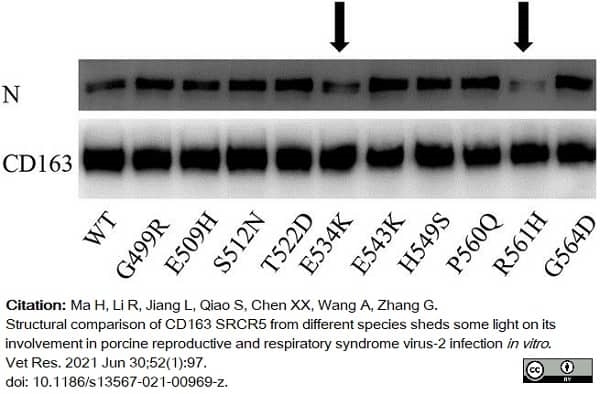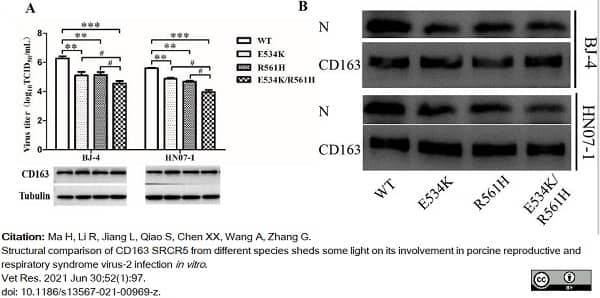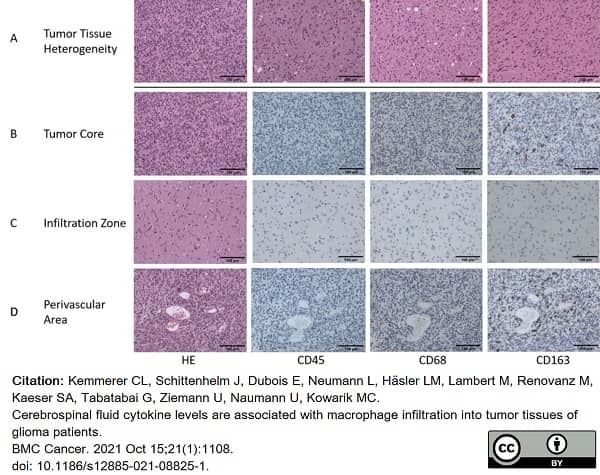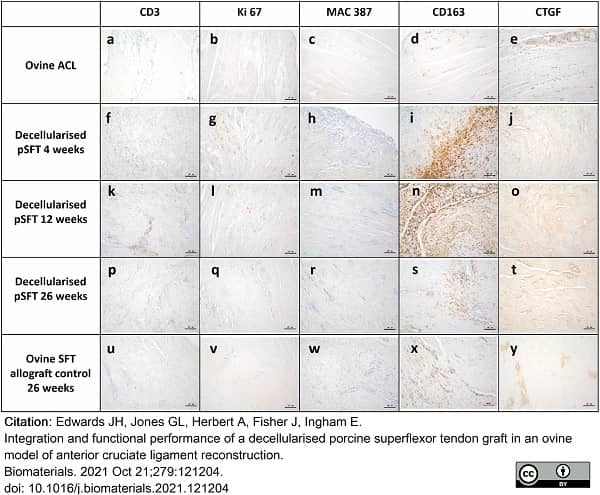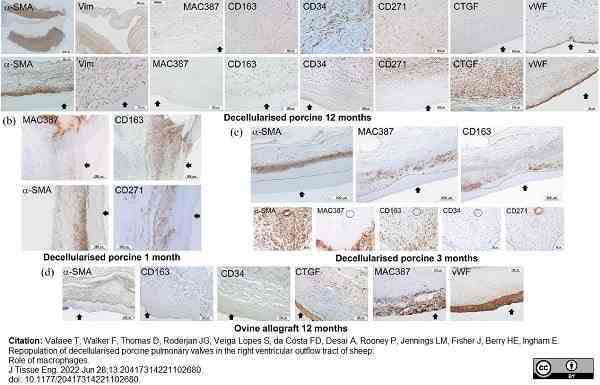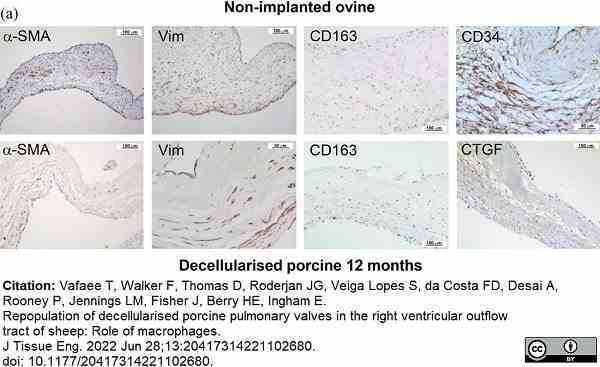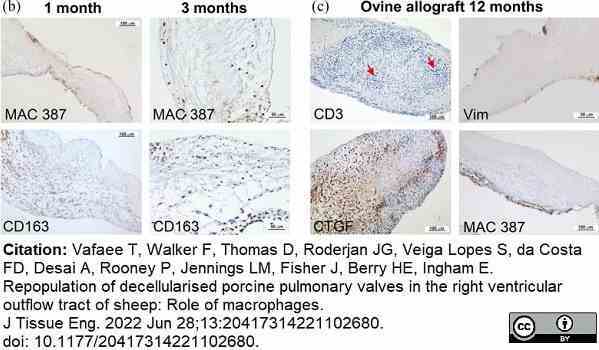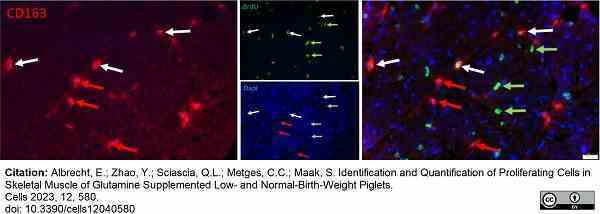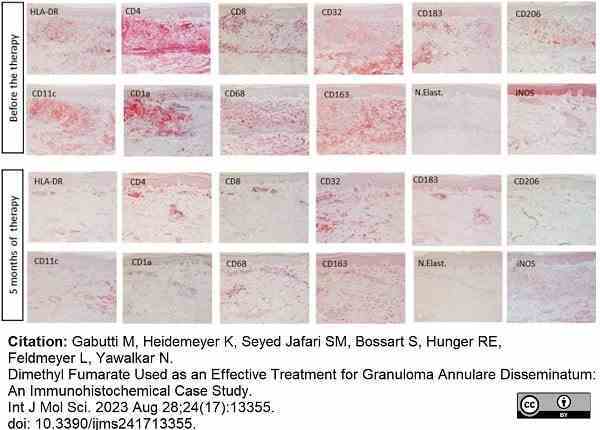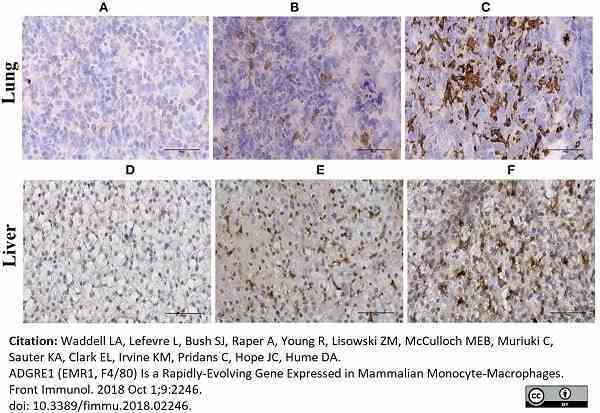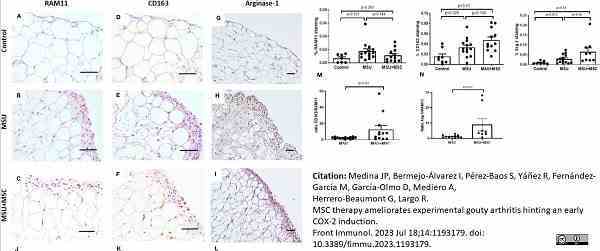CD163 antibody | EDHu-1







































Mouse anti Human CD163
- Product Type
- Monoclonal Antibody
- Clone
- EDHu-1
- Isotype
- IgG1
- Specificity
- CD163
| Mouse anti Human CD163 antibody, clone EDHu-1 recognizes the human CD163 cell surface antigen, a 130-140 kDa glycoprotein expressed by tissue macrophages. CD163 expression may be induced on monocytes by culture in dexamethasone. Clone EDHu-1 is reported to inhibit the binding of haptoglobin/hemoglobin to CD163 (Madsen et al. 2004).Truncation mutation analysis demonstrates binding of EDHu-1 occurs via the N-terminal region of CD163 containing the first three scavenger receptor, Cysteine-rich, SRCR domains the third domain being critical as, cleavage of this domain at the major cleavage site ASP-265 abrogates binding to the N-terminal fragment. |
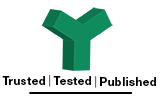
Our CD163 (EDHu-1) Antibody has been referenced in >88 publications* *Based on June 2020 data from CiteAb's antibody search engine. |
- Target Species
- Human
- Species Cross-Reactivity
-
Target Species Cross Reactivity Rhesus Monkey Sheep Pig Guinea Pig Bovine Cynomolgus monkey - N.B. Antibody reactivity and working conditions may vary between species.
- Product Form
- Purified IgG - liquid
- Preparation
- Purified IgG prepared by affinity chromatography on Protein A from tissue culture supernatant
- Buffer Solution
- Phosphate buffered saline
- Preservative Stabilisers
- 0.09% sodium azide (NaN3)
- Carrier Free
- Yes
- Immunogen
- Leucocytes harvested from the pleural cavity of patients with idiopathic spontaneous pneumothorax
- Approx. Protein Concentrations
- IgG concentration 1.0 mg/ml
- Regulatory
- For research purposes only
- Guarantee
- 12 months from date of despatch
Avoid repeated freezing and thawing as this may denature the antibody. Storage in frost-free freezers is not recommended.
| Application Name | Verified | Min Dilution | Max Dilution |
|---|---|---|---|
| ELISA | |||
| Flow Cytometry | 1/10 | 1/50 | |
| Immunoassay | |||
| Immunofluorescence | |||
| Immunohistology - Frozen | |||
| Immunohistology - Paraffin | |||
| Western Blotting |
- Flow Cytometry
- Use 10μl of the suggested working dilution to label 106 cells in 100μl
| Description | Product Code | Applications | Pack Size | List Price | Your Price | Quantity | |
|---|---|---|---|---|---|---|---|
| Mouse IgG1 Negative Control | MCA928 | F | 100 Tests |
|
Log in | ||
| List Price | Your Price | ||||||
|
|
Log in | ||||||
| Description | Mouse IgG1 Negative Control | ||||||
References for CD163 antibody
-
Kristiansen, M. et al. (2001) Identification of the haemoglobin scavenger receptor.
Nature. 409 (6817): 198-201. -
Asleh, R. et al. (2003) Genetically determined heterogeneity in hemoglobin scavenging and susceptibility to diabetic cardiovascular disease.
Circ Res. 92: 1193-200. -
Madsen, M. et al. (2004) Molecular characterization of the haptoglobin.hemoglobin receptor CD163. Ligand binding properties of the scavenger receptor cysteine-rich domain region.
J Biol Chem. 279 (49): 51561-7. -
Montes de Oca, M. et al. (2005) Skeletal muscle inflammation and nitric oxide in patients with COPD.
Eur Respir J. 26: 390-7. -
Wang, X. et al. (2006) Monocyte/macrophage and T-cell infiltrates in peritoneum of patients with ovarian cancer or benign pelvic disease.
J Transl Med. 4: 30. -
Martens JH et al. (2006) Differential expression of a gene signature for scavenger/lectin receptors by endothelial cells and macrophages in human lymph node sinuses, the primary sites of regional metastasis.
J Pathol. 208 (4): 574-89. -
Kim, W.K. et al. (2006) CD163 identifies perivascular macrophages in normal and viral encephalitic brains and potential precursors to perivascular macrophages in blood.
Am J Pathol. 168 (3): 822-34. -
Fabriek, B.O. et al. (2007) The macrophage CD163 surface glycoprotein is an erythroblast adhesion receptor.
Blood 109: 5223-9.
View The Latest Product References
-
Jensen, T.O. et al. (2009) Macrophage markers in serum and tumor have prognostic impact in American Joint Committee on Cancer stage I/II melanoma.
J Clin Oncol. 27: 3330-7. -
Grund, S. et al (2009) The microglial/macrophagic response at the tumour-brain border of invasive meningiomas.
Neuropathol Appl Neurobiol. 35: 82-8. -
Jorgensen, J.M. et al (2009) Expression level, tissue distribution pattern, and prognostic impact of vascular endothelial growth factors VEGF and VEGF-C and their receptors Flt-1, KDR, and Flt-4 in different subtypes of non-Hodgkin lymphomas.
Leuk Lymphoma. 50: 1647-60. -
Moreno, J.A. et al. (2009) The CD163-expressing macrophages recognize and internalize TWEAK: potential consequences in atherosclerosis.
Atherosclerosis. 207: 103-10. -
Boyle, J.J. et al. (2009) Coronary intraplaque hemorrhage evokes a novel atheroprotective macrophage phenotype.
Am J Pathol. 174: 1097-108. -
Moreno JA et al. (2010) Peripheral artery disease is associated with a high CD163/TWEAK plasma ratio.
Arterioscler Thromb Vasc Biol. 30 (6): 1253-62. -
Taus, N.S. et al. (2010) Sheep (Ovis aries) airway epithelial cells support ovine herpesvirus 2 lytic replication in vivo.
Vet Microbiol. 145: 47-53. -
Vinet-Oliphant, H. et al. (2010) Neurokinin-1 receptor (NK1-R) expression in the brains of SIV-infected rhesus macaques: implications for substance P in NK1-R immune cell trafficking into the CNS.
Am J Pathol. 177: 1286-97. -
Herrmann-Hoesing, L.M. (2010) Ovine progressive pneumonia virus capsid antigen as found in CD163- and CD172a-positive alveolar macrophages of persistently infected sheep.
Vet Pathol. 47: 518-28. -
Seeboth, J. et al. (2012) The fungal T-2 toxin alters the activation of primary macrophages induced by TLR-agonists resulting in a decrease of the inflammatory response in the pig.
Vet Res. 43: 35. -
Kong, L.Q. et al. (2013) The clinical significance of the CD163+ and CD68+ macrophages in patients with hepatocellular carcinoma.
PLoS One. 8 (3): e59771. -
Zhang, W. et al. (2013) Myeloid clusters are associated with a pro-metastatic environment and poor prognosis in smoking-related early stage non-small cell lung cancer.
PLoS One 8: e65121. -
Tang, Z. et al. (2013) Glucocorticoids Enhance CD163 Expression in Placental Hofbauer Cells.
Endocrinology 154: 471-82. -
Berglin, L. et al. (2014) In situ characterization of intrahepatic non-parenchymal cells in PSC reveals phenotypic patterns associated with disease severity.
PLoS One 9: e105375. -
Liu, J. et al. (2014) Evidence for mTOR pathway activation in a spectrum of epilepsy-associated pathologies.
Acta Neuropathol Commun. 2: 71. -
Baek, J.H. et al. (2014) Extracellular Hb enhances cardiac toxicity in endotoxemic guinea pigs: protective role of haptoglobin.
Toxins (Basel) 6: 1244-59. -
Micci, L, et al. (2014) CD4 depletion in SIV-infected macaques results in macrophage and microglia infection with rapid turnover of infected cells.
PLoS Pathog. 10: e1004467. -
Pirilä E et al. (2015) Macrophages modulate migration and invasion of human tongue squamous cell carcinoma.
PLoS One 10 (3): e0120895. -
Blair, T.C. et al. (2016) Immunopathology of Japanese macaque encephalomyelitis is similar to multiple sclerosis.
J Neuroimmunol. 291: 1-10. -
Arranz-Solís D et al. (2016) Systemic and local immune responses in sheep after Neospora caninum experimental infection at early, mid and late gestation.
Vet Res. 47 (1): 2. -
Lakritz, J R. et al. (2016) α4-Integrin Antibody Treatment Blocks Monocyte/Macrophage Traffic to, Vascular Cell Adhesion Molecule-1 Expression in, and Pathology of the Dorsal Root Ganglia in an SIV Macaque Model of HIV-Peripheral Neuropathy.
Am J Pathol. 186 (7): 1754-61. -
Fry, L.M. et al. (2016) East Coast Fever Caused by Theileria parva Is Characterized by Macrophage Activation Associated with Vasculitis and Respiratory Failure.
PLoS One 11 (5): e0156004. -
Wächter, C. et al. (2016) Loss of cerebellar neurons in the progression of lentiviral disease: effects of CNS-permeant antiretroviral therapy.
J Neuroinflammation. 13 (1): 272. -
Derricott, H. et al. (2016) Characterizing Villitis of Unknown Etiology and Inflammation in Stillbirth.
Am J Pathol. 186 (4): 952-61. -
Zhu, C. et al. (2017) Activation of CECR1 in M2-like TAMs promotes paracrine stimulation-mediated glial tumor progression.
Neuro Oncol. 19 (5): 648-59. -
Furukawa S et al. (2017) Interleukin-33 produced by M2 macrophages and other immune cells contributes to Th2 immune reaction of IgG4-related disease.
Sci Rep. 7: 42413. -
Mallard, J. et al. (2017) A method for obtaining simian immunodeficiency virus RNA sequences from laser capture microdissected and immune captured CD68+ and CD163+ macrophages from frozen tissue sections of bone marrow and brain.
J Immunol Methods. 442: 59-63. -
Farina, A. et al. (2017) Epstein-Barr virus lytic infection promotes activation of Toll-like receptor 8 innate immune response in systemic sclerosis monocytes.
Arthritis Res Ther. 19 (1): 39. -
Schultz, N. et al. (2017) Amylin alters human brain pericyte viability and NG2 expression.
J Cereb Blood Flow Metab. 37 (4): 1470-82. -
Boxberg, M. et al. (2018) PD-L1 and PD-1 and characterization of tumor-infiltrating lymphocytes in high grade sarcomas of soft tissue - prognostic implications and rationale for immunotherapy.
Oncoimmunology. 7 (3): e1389366. -
Waddell, L.A. et al. (2018) ADGRE1 (EMR1, F4/80) Is a Rapidly-Evolving Gene Expressed in Mammalian Monocyte-Macrophages.
Front Immunol. 9: 2246. -
Eligini, S. et al. (2019) Biological profile of monocyte-derived macrophages in coronary heart disease patients: implications for plaque morphology.
Sci Rep. 9 (1): 8680. -
Chen, J. et al. (2019) Generation of Pigs Resistant to Highly Pathogenic-Porcine Reproductive and Respiratory Syndrome Virus through Gene Editing of CD163.
Int J Biol Sci. 15 (2): 481-492. -
Zhao, S. et al. (2020) CD14+ monocytes and CD163+ macrophages correlate with the severity of liver fibrosis in patients with chronic hepatitis C
Experimental and Therapeutic Medicine. 20 (6): 1-1. -
Hayashi, K. et al. (2020) The Natural History of Spontaneously Occurred Endometriosis in Cynomolgus Monkeys by Monthly Follow-Up Laparoscopy for Two Years.
Tohoku J Exp Med. 251 (4): 241-53. -
Pestronk, A. (2020) Chronic Graft Versus Host Myopathies: Noninflammatory, Multi-Tissue Pathology With Glycosylation Disorders.
J Neuropathol Exp Neurol. 79 (1): 102-12. -
Palaiologou, E. et al. (2020) Human placental villi contain stromal macrovesicles associated with networks of stellate cells.
J Anat. 236 (1): 132-41. -
Frafjord, A. et al. (2020) Antibody combinations for optimized staining of macrophages in human lung tumours.
Scand J Immunol. 92 (1): e12889. -
Ströbel, S. et al. (2021) A 3D primary human cell-based in vitro model of non-alcoholic steatohepatitis for efficacy testing of clinical drug candidates.
Sci Rep. 11 (1): 22765. -
Ikezumi, Y. et al. (2021) Steroid treatment promotes an M2 anti-inflammatory macrophage phenotype in childhood lupus nephritis.
Pediatr Nephrol. 36 (2): 349-59. -
Edwards, J.H. et al. (2021) Integration and functional performance of a decellularised porcine superflexor tendon graft in an ovine model of anterior cruciate ligament reconstruction.
Biomaterials. 279: 121204. -
Kemmerer, C.L. et al. (2021) Cerebrospinal fluid cytokine levels are associated with macrophage infiltration into tumor tissues of glioma patients
BMC Cancer. 21(1):1108. -
Lehmann, M. et al. (2021) New onset of mainly guttate psoriasis after COVID-19 vaccination: a case report.
J Eur Acad Dermatol Venereol. 35 (11): e752-e755. -
Gonçalves, V.M. et al. (2021) Macrophage and Lymphocyte Infiltration Is Associated with Volumetric Tumor Size but Not with Volumetric Growth in the T&yyml;bingen Schwannoma Cohort.
Cancers (Basel). 13 (3): 466. -
Baumann, D. et al. (2021) p38 MAPK signaling in M1 macrophages results in selective elimination of M2 macrophages by MEK inhibition.
J Immunother Cancer.9 (7): e002319. -
da Silva M.C.M. et al. (2021) Inhibition of CSF1R, a receptor involved in microglia viability, alters behavioral and molecular changes induced by cocaine.
Sci Rep. 11 (1): 15989. -
Ma, H. et al. (2021) Structural comparison of CD163 SRCR5 from different species sheds some light on its involvement in porcine reproductive and respiratory syndrome virus-2 infection in vitro..
Vet Res. 52 (1): 97. -
Holsapple, J.S. et al. (2021) Low Intensity Shockwave Treatment Modulates Macrophage Functions Beneficial to Healing Chronic Wounds.
Int J Mol Sci. 22(15):7844. -
Galea, I. et al. (2022) Iron Deposition in the Brain After Aneurysmal Subarachnoid Hemorrhage.
Stroke. 53 (5): 1633-42. -
Bartalska, K. et al. (2022) A systematic characterization of microglia-like cell occurrence during retinal organoid differentiation.
iScience. 25 (7): 104580. -
Pooley, H.B. et al. (2022) Sheep vaccinated against paratuberculosis have increased levels of B cells infiltrating the intestinal tissue.
Vet Immunol Immunopathol. 252: 110482. -
Rabufetti, A. et al. (2022) New onset of sarcoidosis after COVID-19 infection.
J Eur Acad Dermatol Venereol. 36 (10): e756-e759. -
Vafaee, T. et al. (2022) Repopulation of decellularised porcine pulmonary valves in the right ventricular outflow tract of sheep: Role of macrophages.
J Tissue Eng. 13: 20417314221102680. -
Albrecht, E. et al. (2023) Identification and Quantification of Proliferating Cells in Skeletal Muscle of Glutamine Supplemented Low- and Normal-Birth-Weight Piglets
Cells. 12 (4): 580. -
Park, S.M. et al. (2023) Seven-colour multiplex immunochemistry/immunofluorescence and whole slide imaging of frozen sections.
J Immunol Methods. 518: 113490. -
Wu, H. et al. (2023) Electrical stimulation of piezoelectric BaTiO3 coated Ti6Al4V scaffolds promotes anti-inflammatory polarization of macrophages and bone repair via MAPK/JNK inhibition and OXPHOS activation.
Biomaterials. 293: 121990. -
Lin, C. et al. (2023) Macrophage-like rapid uptake and toxicity of tattoo ink in human monocytes.
Immunology. Nov 14 [Epub ahead of print]. -
Gabutti, M. et al. (2023) Dimethyl Fumarate Used as an Effective Treatment for Granuloma Annulare Disseminatum: An Immunohistochemical Case Study.
Int J Mol Sci. 24 (17): 13355 -
White, K.S. et al. (2023) Simian immunodeficiency virus-infected rhesus macaques with AIDS co-develop cardiovascular pathology and encephalitis.
Front Immunol. 14: 1240946. -
Medina, J.P. et al. (2023) MSC therapy ameliorates experimental gouty arthritis hinting an early COX-2 induction.
Front Immunol. 14: 1193179.
- RRID
- AB_2074540
- UniProt
- Q86VB7
- Entrez Gene
- CD163
- GO Terms
- GO:0005515 protein binding
- GO:0006953 acute-phase response
- GO:0005576 extracellular region
- GO:0005044 scavenger receptor activity
- GO:0005887 integral to plasma membrane
Please Note: All Products are "FOR RESEARCH PURPOSES ONLY"
View all Anti-Human ProductsAlways be the first to know.
When we launch new products and resources to help you achieve more in the lab.
Yes, sign me up